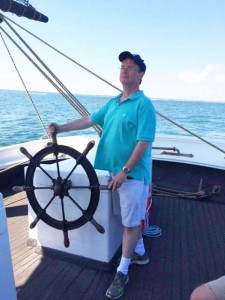 In The Perfect Storm, George Clooney dies when the ship sinks. In Titanic, Leonardo Dicaprio dies when the ship sinks. In All is Lost—spoiler alert—Robert Redford makes it, but just barely. When I get on a boat I think about these movies, because I cannot swim. I have come to believe that water, more than any other place, is where people drown. I understand why “seasick” is a word and “landsick” is not. I do not even go to Old Navy. I have biblical support for my attitude. In the Psalms, the Leviathan is lurking beneath the boat just like Jaws. No thinking parent would tell the stories of Noah or Jonah at bedtime. Egyptian children have bad dreams about crossing the Red Sea.
In The Perfect Storm, George Clooney dies when the ship sinks. In Titanic, Leonardo Dicaprio dies when the ship sinks. In All is Lost—spoiler alert—Robert Redford makes it, but just barely. When I get on a boat I think about these movies, because I cannot swim. I have come to believe that water, more than any other place, is where people drown. I understand why “seasick” is a word and “landsick” is not. I do not even go to Old Navy. I have biblical support for my attitude. In the Psalms, the Leviathan is lurking beneath the boat just like Jaws. No thinking parent would tell the stories of Noah or Jonah at bedtime. Egyptian children have bad dreams about crossing the Red Sea.
I have historical support for my attitude—the Bismarck, the Lusitania, the Poseidon, the Voyage of the Damned, and the Sloop John B, as well as pirates with hooks for hands and pegs for legs.
Carol and I are, nonetheless, delighted when Peter and Lee Scott take us on the S.S. Alabama for a “three hour tour”—just like Gilligan’s. This is another chance to learn to love the ocean.
I count the people on board—thirty—and the seats on the lifeboat—twelve. These are not the odds for which you hope. A guy from Michigan—not me—asks about life jackets. The life preservers are in the bottom of the boat. If the boat starts to sink, they expect me to run downstairs. I am humming “The Wreck of the Edmund Fitzgerald.”
The barefoot crew of the S.S. Alabama is made up of teenagers. The Captain’s name—I am not making this up—is Morgan. This does not inspire confidence. Captain Morgan warns us to watch out for the boom, as it could kill us.
After thirty minutes, I stop staring at the boom. We eat ham sandwiches and mint fudge. (I prefer regular fudge, but sea life is hard.) I start saying things like, “That’s a good-looking flying jib.” I tell Carol, “I’m getting sunburned on my starboard side.”
Lee makes friends with everybody on board. She gets Maureen’s email address, so she can send her recipe for spinach pie.
After two hours, I am scanning the horizon while I steer the Alabama. I am looking for boats with bad names—Ahoy Vey, Yacht Sea, Gravyboat, She Got the House, Buoys in the Hood. Then again—I wish I was the first one to say this—if it doesn’t come when you call it, why name it?
In Mark’s Gospel, Jesus is sleeping below deck when a storm shows up. The frightened disciples wake him up. When he has gotten his eyes open, Jesus speaks first to the wind rather than the disciples, “Cut that out!” He is gentler with the sea, “Take it easy. Quiet down.” As Mary Oliver writes, “the sea lays down, silky and sorry.”
Sometimes it makes sense to feel nervous. At other times we just need to be still. We cannot always decide how afraid or hopeful we will be, but we get to choose which way we will lean. We get to decide if we will share our fears with God. We may still feel nervous, but we can know that we are not alone. We can eat a sandwich and try some fudge.